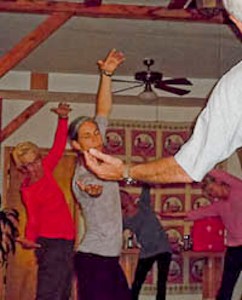Wisdom Through the Moving Body….
A reflection on practice by Wynn Fricke
 Dance as with other movement practices, demands heightened awareness of the body – the Buddha’s first foundation of mindfulness. Like an instrument, our bodies are tuned with mindful attention. Whether mastering a step, improvising freely, or choreographing, we are connected into the world of touch and sensation. We gather the mind within the physical experience. We listen to the body as we learn its rules and impulses. We are embodied.
Dance as with other movement practices, demands heightened awareness of the body – the Buddha’s first foundation of mindfulness. Like an instrument, our bodies are tuned with mindful attention. Whether mastering a step, improvising freely, or choreographing, we are connected into the world of touch and sensation. We gather the mind within the physical experience. We listen to the body as we learn its rules and impulses. We are embodied.
The moving body provides unique feedback from our nervous system. Kind attention to the body through movement nourishes the body and generates its own form of intelligence. It is basic to our sense of well-being.
Bodily sensations also reveal states of mind. Mental tensions, emotions, and imagery felt and expressed within the physical terrain can be a source of insight and creativity. With the support of our movement and meditation practices, the mind-body relationship can be seen more clearly.
In dance and with the movement practice the body itself is the instrument of creative expression, and can highlight one’s personal identification with how the body looks, feels and moves. This heightened vulnerability is an opportunity to explore the sense of self as it manifests in the form of bodily contraction.
highlight one’s personal identification with how the body looks, feels and moves. This heightened vulnerability is an opportunity to explore the sense of self as it manifests in the form of bodily contraction.
For instance, in a moment of humiliation there is a feeling that “squeezes our hearts” as Ajahn Chah describes. Fear, doubt, clinging, and self-aggrandizement can be observed in our bodies again and again. These moments of self-consciousness are potent opportunities for insight. Observing the arising of self-view, free from judgment is a source of joy – the joy of release.
We can make an intentional and courageous practice of learning about suffering and its release through our disciplines of movement.
See more about Wynn Fricke
